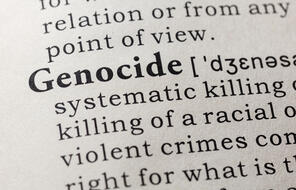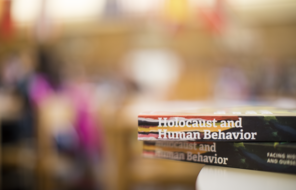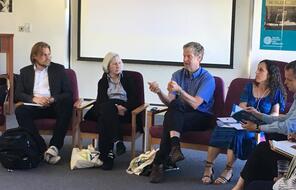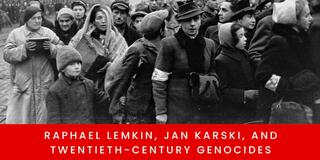
6 New Books on Genocide
Here at Facing History, we see awareness months as opportunities to deepen our knowledge of and attention to the histories and contemporary manifestations of various phenomena. However, the focus on these themes over one particular month can further marginalize the very phenomena we are hoping to elevate. With this in mind, what follows is an invitation to engage with important themes raised by Genocide Awareness Month this April and throughout all of the months of the year.
Below are six books that have been released in the last year that elevate understudied aspects of and connections between multiple historical genocides as well as the contemporary task of genocide prevention in a global climate of rising hate. Below is promotional text excerpted from material offered by each book’s publisher:
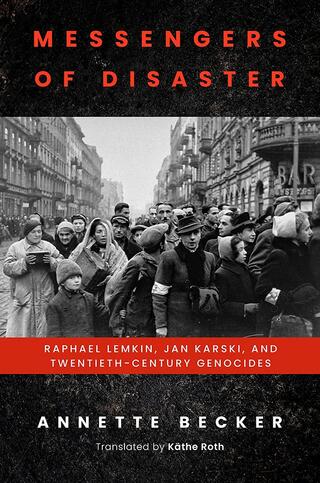
Messengers of Disaster: Raphael Lemkin, Jan Karski, and Twentieth-Century Genocides
Messengers of Disaster: Raphael Lemkin, Jan Karski, and Twentieth-Century Genocides
By Annette Becker
“Leading up to World War II, two Polish men witnessed the targeted extermination of Jews under Adolf Hitler and the German Reich before the reality of the Holocaust was widely known. Raphael Lemkin, a Jewish lawyer who coined the term ‘genocide,’ and Jan Karski, a Catholic member of the Polish resistance, independently shared this knowledge with Winston Churchill and Franklin D. Roosevelt. Having heard false rumors of wartime atrocities before, the leaders met the messengers with disbelief and inaction, leading to the eventual murder of more than six million people.
Messengers of Disaster draws upon little-known texts from an array of archives, including the International Committee of the Red Cross in Geneva and the International Tracing Service in Bad Arolsen. Carrying the knowledge of disaster took a toll on Lemkin and Karski, but their work prepared the way for the United Nations to unanimously adopt the first human rights convention in 1948 and influenced the language we use to talk about genocide today. Annette Becker's detailed study of these two important figures illuminates how distortions of fact can lead people to deny knowledge of what is happening in front of their own eyes.” – University of Wisconsin Press
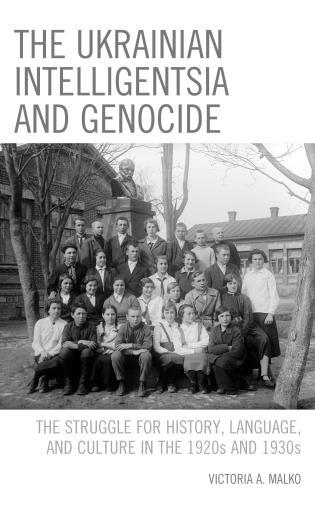
The Ukrainian Intelligentsia and Genocide: The Struggle for History, Language, and Culture in the 1920s and 1930s
The Ukrainian Intelligentsia and Genocide: The Struggle for History, Language, and Culture in the 1920s and 1930s
By Victoria A. Malko
“This study focuses on the first group targeted in the genocide known as the Holodomor: Ukrainian intelligentsia, the ‘brain of the nation,’ using the words of Raphael Lemkin, who coined the term genocide and enshrined it in international law. The study’s author examines complex and devastating effects of the Holodomor on Ukrainian society during the 1920–1930s. Members of intelligentsia had individual and professional responsibilities. They resisted, but eventually they were forced to serve the Soviet regime. Ukrainian intelligentsia were virtually wiped out, most of its writers and a third of its teachers. The remaining cadres faced a choice without a choice if they wanted to survive. The author analyzes how and why this process occurred and what role intellectuals, especially teachers, played in shaping, contesting, and inculcating history. Crucially, the author challenges Western perceptions of the all-Union famine that was allegedly caused by ad hoc collectivization policies, highlighting the intentional nature of the famine as a tool of genocide, persecution, and prosecution of the nationally conscious Ukrainian intelligentsia, clergy, and grain growers.” – Lexington Books
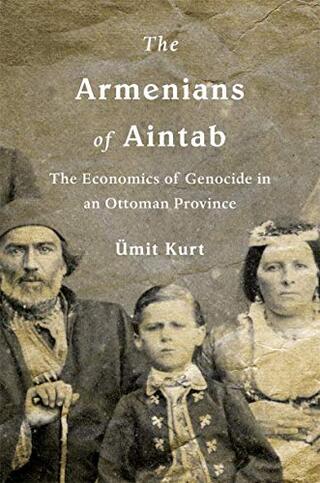
The Armenians of Aintab: The Economics of Genocide in an Ottoman Province
The Armenians of Aintab: The Economics of Genocide in an Ottoman Province
By Ümit Kurt
“Ümit Kurt, born and raised in Gaziantep, Turkey, was astonished to learn that his hometown once had a large and active Armenian community. The Armenian presence in Aintab, the city’s name during the Ottoman period, had not only been destroyed―it had been replaced… Kurt digs into the details of the Armenian dispossession that produced the homogeneously Turkish city in which he grew up. In particular, he examines the population that gained from ethnic cleansing. Records of land confiscation and population transfer demonstrate just how much new wealth became available when the prosperous Armenians―who were active in manufacturing, agricultural production, and trade―were ejected. Although the official rationale for the removal of the Armenians was that the group posed a threat of rebellion, Kurt shows that the prospect of material gain was a key motivator of support for the Armenian genocide among the local Muslim gentry and the Turkish public. Those who benefited most―provincial elites, wealthy landowners, state officials, and merchants who accumulated Armenian capital―in turn financed the nationalist movement that brought the modern Turkish republic into being…
The Armenians of Aintab draws on primary sources from Armenian, Ottoman, Turkish, British, and French archives, as well as memoirs, personal papers, oral accounts, and newly discovered property-liquidation records. Together they provide an invaluable account of genocide at ground level.”
– Harvard University Press
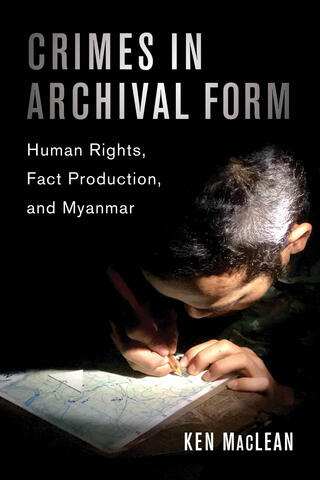
Crimes in Archival Form: Human Rights, Fact Production, and Myanmar
Crimes in Archival Form: Human Rights, Fact Production, and Myanmar
By Ken MacLean
“Crimes in Archival Form explores the many ways in which human rights ‘facts’ are produced rather than found. Using Myanmar as his case study, Ken MacLean examines the fact-finding practices of a human rights group, two cross-border humanitarian agencies, an international law clinic, and a global NGO-led campaign. Foregrounding fact-finding, in critical yet constructive ways, prompts long overdue conversations about the possibilities and limits of human rights documentation as a mode of truth-seeking. Such conversations are particularly urgent in an era when the perpetrators of large-scale human rights violations exploit misinformation, weaponize disinformation, and employ outright falsehoods, including deepfakes, to undermine the credibility of those who document abuses and demand accountability in the court of public opinion and in courts of law. MacLean compels practitioners and scholars alike to be more transparent about how human rights ‘fact’ production works, why it is important, and when its use should prompt concern.” – University of California Press
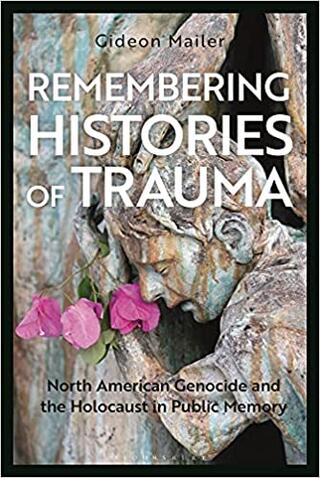
Remembering Histories of Trauma: North American Genocide and the Holocaust in Public Memory
Remembering Histories of Trauma: North American Genocide and the Holocaust in Public Memory
By Gideon Mailer
“Remembering Histories of Trauma compares and links Native American, First Nation and Jewish histories of, and approaches to, traumatic memory. Using source material from both sides of the Atlantic, it examines the differences between these people's ancestral experiences of genocide and the representation of those histories in public sites in the United States, Canada and Europe. Challenging the ways public bodies have used those histories to frame the cultural and political identity of regions, states, and nations, it considers and compares the effects of those representations on internal group memory, external public memory and cultural assimilation.
Offering new ways to understand the Native-Jewish encounter… Mailer seeks to transcend historical tensions between Native American studies and Holocaust studies… In revealing similarities in the public representation of Indigenous genocide and the Holocaust it offers common ground for Jewish and Indigenous histories and provides a new framework to better understand the divergence between traumatic histories and the ways they are memorialized.” – Bloomsbury Academic
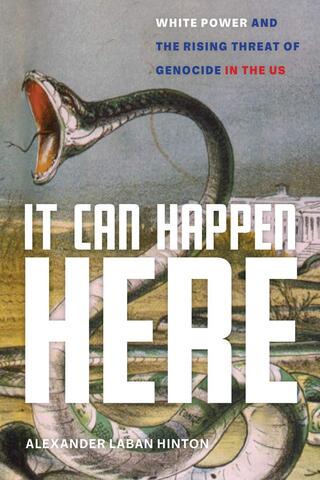
It Can Happen Here: White Power and the Rising Threat of Genocide in the U.S.
It Can Happen Here: White Power and the Rising Threat of Genocide in the U.S.
By Alexander Laban Hinton
“It Can Happen Here demonstrates that, rather than being exceptional…white power extremism and the violent atrocities linked to it are a part of American history. And, alarmingly, they remain a very real threat to the US today. Alexander Hinton explains how murky politics, structural racism, the promotion of American exceptionalism, and a belief that the US has have achieved a color-blind society have diverted attention from the deep roots of white supremacist violence in the US’s brutal past. Drawing on his years of research and teaching on mass violence, Hinton details the warning signs of impending genocide and atrocity crimes, the tools used by ideologues to fan the flames of hate, and the shocking ways in which “us” versus “them” violence is supported by inherently racist institutions and policies.
It Can Happen Here is an essential new assessment of the dangers of contemporary white power extremism in the United States. While revealing the threat of genocide and atrocity crimes that loom over the country, Hinton offers actions we can take to prevent it from happening, illuminating a hopeful path forward for a nation in crisis.” – NYU Press
Facing History and Ourselves invites educators to use our Teaching Idea Genocide Still Happens in the classroom.

